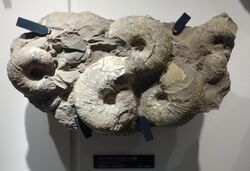Biology:Menuites
| Menuites | |
|---|---|

| |
| Menuites soyaensis | |
| Scientific classification | |
| Domain: | Eukaryota |
| Kingdom: | Animalia |
| Phylum: | Mollusca |
| Class: | Cephalopoda |
| Subclass: | †Ammonoidea |
| Order: | †Ammonitida |
| Family: | †Pachydiscidae |
| Genus: | †Menuites Spath, 1922 |
Menuites is a genus of extinct ammonites, forming a rather small offshoot of Anapachydiscus with a fairly widespread distribution from the Upper Cretaceous Santonian and Campanian stages.
The inner whorls of this pachydiscid have fine, straight or slightly curved, radial, ribs, characteristic of Anapachydiscus. The long body, or living, chamber is with prominent rounded umbilical tubercles and ventrolateral tubercles set on irregular, wide-spaced, rounded ribs.
Distribution
Fossils of Menuites have been found in Angola, Antarctica, Australia, Austria, Chile, France, Germany, India, Iran, Japan, Mexico, the Netherlands, the Russian Federation, South Africa and the United States (Arkansas, Delaware, New Jersey, Wyoming).[1]
References
- ↑ Menuites at Fossilworks.org
Further reading
- Treatise on Invertebrate Paleontology, Part L, Ammonoidea. R.C. Moore (ed). Mesozoic Ammonoidea, p. L 180.
- The Upper Cretaceous Dimorphic Pachydiscid Ammonite Menuites in the Western Interior of the United States, William A. Cobban and W. James Kennedy, U.S. Geological Survey Professional Paper 1533, 1993. [1]
Wikidata ☰ Q6817679 entry
 |

